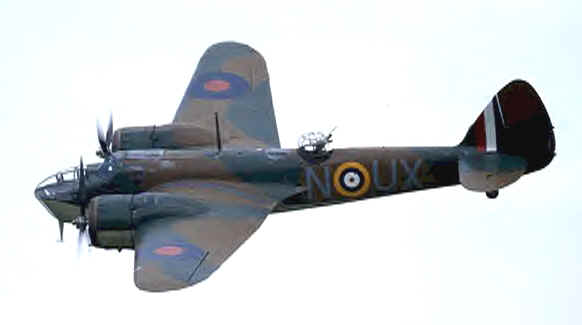|

(Photo courtesy Paul Vitone)
History:
The Blenheim was originally built
in in England in 1934 as one of the first executive planes for the proprietor of the Daily
Mail, Lord Rothermere, who wanted a fast plane capable of carrying six passengers, a pilot
and a co-pilot. Equipped with two Bristol Mercury engines, the Bristol Type
142, as it was then called, was 30 mph (48km/h) faster than the RAF's new
biplane fighter, the Gloster Gauntlet.
Bristol began designing a military version of their new aircraft, the Type
142M. The Air Ministry placed an order for 150 aircraft in the summer of
1935, and a second order for 434 more followed in July of 1937. The Type 142M, or Blenheim
I, as it was now called, had a bomb aimer's station in the nose, an internal
bomb bay, and a dorsal machine gun turret for self-defense. There was also a single
machine gun in the port wing. The Blenheim was of all-metal construction, with the nose of
the plane barely extending beyond the engines. It was equipped with two Bristol Mercury
engines. When first revealed to the public, the Blenheim's speed attracted great notice
and led to the belief Britain was armed with the best bomber in the world. This myth
became self-perpetuating and soon two new production lines had to be set up as orders for
still more aircraft were placed. A total of 1,552 Blenheim Is were built and equipped 26
RAF squadrons at home and in British possessions in the Middle East (e.g. Egypt, Iraq,
Aden) and the Far East (e.g. India, Malaya/Malaysia, Singapore).
During the early stages of development the Bristol company designed a derivative of the
Blenheim, the Type 149, in response to an Air Ministry request
for a coastal reconnaissance and light bomber aircraft to replace the Avro Anson. The Type
149 was a Blenheim with greater fuel capacity and a lengthened nose for an observer and
his gear. The Air Ministry then began to worry that this new aircraft would interfere with
the production of the Blenheim I already underway. Instead, the Royal Canadian Air Force
(RCAF) ordered production in Canada as the Bolingbroke Mk I, and
the prototype was shipped to Canada to help start the production lines at Fairchild
Aircraft Ltd. The Type 149 would enter production in the UK as the Blenheim Mk
IV. By 1939, most Blenheim Is had been replaced in Britain by the new Mk IV.
The Mk Is continued to serve as trainers and a number were converted into night fighters.
The night fighter version, the Blenheim IF, was equipped with a
special under-fuselage pack that housed four machineguns, and an airborne interception
radar. It was a Blenheim IF that made the first radar-assisted kill of the war in July of
1940. The Blenheim would also become the first aircraft to make reconnaissance and bombing
raids into Germany during the opening stages of the war in the west. The Blenheim Mk IV
would equip 70 squadrons at its height of popularity, and continue to serve in the Middle
and Far East until the last years of the war. A Blenheim Mk V
was also built, with extra armor and weapons, but the same engines. This meant it was an
extremely slow aircraft and after serious losses in Italy, it was withdrawn from service.
Today only a single Blenheim Mk.1
remains airworthy. It is owned and operated by the Aircraft Restoration Company at Duxford, UK, and
returned to flying condition in 2014.
Nicknames: Blenburgher (early
Blenheim nickname); Bisley (nickname for the Mk.V version; Refers to the home of
the National Rifle Association in the UK); Boly (Canadian nickname for the
Bolingbroke).
Specifications (Blenheim Mk IV):
Engines: Two 905-hp Bristol Mercury XV radial piston engines
Weight: Empty 9,790 lbs., Max
Takeoff 14,400 lbs.
Wing Span: 56ft. 4in.
Length: 42ft. 7in.
Height: 9ft. 10in.
Performance:
Maximum Speed:
266 mph
Cruising Speed:
198 mph
Ceiling: 27,260
ft.
Range: 1,460
miles
Armament: Three 7.7-mm (0.303-inch)
machine guns, plus up to 1,000 pounds of bombs internally and 320 pounds externally.
Number Built: 4,422
Number Still Airworthy: One
Links:
Aircraft Restoration Company (UK) --
Blenheim Page -- The only airworthy Blenheim.
Canadian Warplane
Heritage Museum -- Bolingbroke
RAF 211 Squadron (Bomber) --
Don Clark's very informative site on a WWII Blenheim squadron.
Wikipedia -- Bristol Blenheim
Wikipedia -- Bristol Bolingbroke

[Back to Warbird Alley's Main
Page]
All text and photos Copyright 2016 The Doublestar Group, unless otherwise noted.
You may use this page for your own, non-commercial reference purposes only.
 |